The global car OS market is valued at USD 563.2 million in 2025 and is set to reach USD 1,107.9 million by 2035, recording an absolute increase of USD 544.7 million over the forecast period. This translates into a total growth of 96.7%, with the car OS market forecast to expand at a CAGR of 7.0% between 2025 and 2035. The overall market size is expected to grow by approximately 2.0X during the same period, supported by increasing adoption of connected vehicle technologies, growing demand for advanced infotainment systems, and rising requirements for seamless cockpit integration across automotive manufacturers and technology developers.
The global car OS market is a rapidly evolving segment of the automotive technology industry, driven by the digital transformation of vehicle systems and rising consumer expectations for smartphone-like experiences in automobiles. Car operating systems serve as the foundational software platform that manages vehicle functions, from basic infotainment and navigation to advanced driver assistance systems and autonomous driving capabilities. The proliferation of electric vehicles, the emergence of software-defined vehicles, and the growing emphasis on over-the-air updates have positioned car OS as a critical differentiator for automotive manufacturers seeking to enhance user experience and maintain competitive advantage.

The car OS market encompasses a range of OS architectures and deployment models, including embedded systems, Android-based platforms, Linux distributions, and proprietary solutions developed specifically for automotive applications. Modern car OS platforms integrate sophisticated middleware layers that enable seamless communication between hardware components, support multiple concurrent applications, and provide robust security frameworks to protect against cyber threats. The integration of artificial intelligence, machine learning, and cloud connectivity has further enhanced the functionality of contemporary car OS solutions, enabling predictive maintenance, personalized user experiences, and advanced analytics.
Market dynamics are significantly influenced by the automotive industry's shift toward electrification and autonomous driving, which require more sophisticated software platforms capable of handling complex computational tasks and real-time decision-making. The increasing collaboration between traditional automotive manufacturers and technology companies has accelerated innovation in car OS development, leading to more standardized platforms and improved interoperability across different vehicle systems. Additionally, regulatory requirements for vehicle cybersecurity and data privacy have driven investment in secure OS architectures and advanced encryption technologies.
Consumer preferences increasingly favor vehicles equipped with advanced digital cockpits, voice recognition systems, and seamless smartphone integration capabilities. The car OS market has witnessed significant technological advancement in user interface design, multi-modal interaction systems, and personalization features that adapt to individual driver preferences and behaviors. The growing trend toward subscription-based services and over-the-air feature updates has created new revenue opportunities for OS developers and automotive manufacturers, fundamentally changing the traditional vehicle ownership model.
Between 2025 and 2030, the car OS market is projected to expand from USD 563.2 million to USD 789.9 million, resulting in a value increase of USD 226.7 million, which represents 41.6% of the total forecast growth for the decade. This phase of development will be shaped by increasing adoption of connected vehicle technologies, rising integration of artificial intelligence in automotive systems, and growing availability of advanced cockpit solutions across premium and mainstream vehicle segments.
Between 2030 and 2035, the car OS market is forecast to grow from USD 789.9 million to USD 1,107.9 million, adding another USD 318.0 million, which constitutes 58.4% of the overall ten-year expansion. This period is expected to be characterized by the advancement of autonomous driving capabilities, the development of software-defined vehicle architectures, and the expansion of over-the-air update systems across diverse automotive applications. The growing emphasis on digital transformation and connected mobility will drive demand for advanced car OS varieties with enhanced AI integration, improved cybersecurity features, and superior cloud connectivity performance profiles.
Between 2020 and 2024, the car OS market experienced accelerated growth, driven by increasing consumer demand for digital cockpit experiences and growing recognition of software's critical role in modern vehicle differentiation following extensive industry digitalization initiatives. The car OS market developed as automotive manufacturers recognized the limitations of traditional embedded systems in addressing complex infotainment and connectivity requirements and began seeking comprehensive OS solutions designed specifically for automotive environments. Technological advancement in cloud computing and artificial intelligence began emphasizing the critical importance of maintaining software flexibility while enhancing system performance and improving user experience across diverse vehicle applications.
| Metric | Value |
|---|---|
| Estimated Value in (2025E) | USD 563.2 million |
| Forecast Value in (2035F) | USD 1,107.9 million |
| Forecast CAGR (2025 to 2035) | 7.0% |
From 2030 to 2035, the car OS market is forecast to grow from USD 789.9 million to USD 1,107.9 million, adding another USD 318.0 million, which constitutes 58.4% of the overall ten-year expansion. This period is expected to be characterized by the advancement of edge computing integration in vehicle systems, the integration of 5G connectivity for real-time data processing, and the development of specialized OS platforms for autonomous vehicle operations. The growing emphasis on vehicle-as-a-service models and digital ecosystem integration will drive demand for premium varieties with enhanced cloud-native architectures, improved multi-domain capabilities, and superior scalability characteristics.
Between 2020 and 2024, the car OS market experienced robust growth, driven by increasing awareness of software-defined vehicle benefits and growing recognition of advanced OS platforms' effectiveness in supporting next-generation automotive experiences across connected vehicle applications and intelligent transportation systems. The car OS market developed as users recognized the potential for sophisticated car OS solutions to deliver competitive advantages while meeting modern requirements for comprehensive vehicle digitalization and reliable performance monitoring. Technological advancement in containerization technologies and microservices architectures began emphasizing the critical importance of maintaining system modularity while extending platform capabilities and improving development efficiency across diverse automotive OS applications.
Market expansion is being supported by the increasing global adoption of connected vehicle technologies and the corresponding shift toward advanced car OS platforms that can provide superior integration characteristics while meeting user requirements for comprehensive digital cockpit management and cost-effective vehicle software solutions. Modern automotive manufacturers are increasingly focused on incorporating OS platforms that can enhance vehicle differentiation while satisfying demands for consistent, precisely managed user experiences and optimized development practices. Car OS platforms' proven ability to deliver software integration excellence, user experience improvement, and diverse application possibilities makes them essential components for technology-focused manufacturers and innovation-driven automotive professionals.
The growing emphasis on autonomous driving technologies and vehicle electrification is driving demand for high-performance car OS systems that can support distinctive computational capabilities and comprehensive system management across electric vehicle platforms, autonomous driving applications, and premium connected vehicle developments. Manufacturer preference for OS solutions that combine functional excellence with scalability advantages is creating opportunities for innovative implementations in both traditional and emerging automotive technology applications. The rising influence of artificial intelligence and machine learning technologies is also contributing to increased adoption of specialized car OS solutions that can provide authentic intelligence benefits and reliable data processing characteristics.
The car OS market is segmented by type, application, deployment model, vehicle type, and region. By type, the car OS market is divided into vehicle-controlled operating system, on-vehicle operating system, cloud-based operating system, and hybrid operating system. Based on application, the car OS market is categorized into cockpit interaction, infotainment, navigation systems, vehicle diagnostics, and others. By deployment model, the car OS market includes embedded systems, cloud-native platforms, edge computing solutions, and distributed architectures. By vehicle type, the car OS market encompasses passenger cars, commercial vehicles, electric vehicles, and autonomous vehicles. Regionally, the car OS market is divided into North America, Europe, Asia Pacific, Latin America, Middle East & Africa, and other regions.
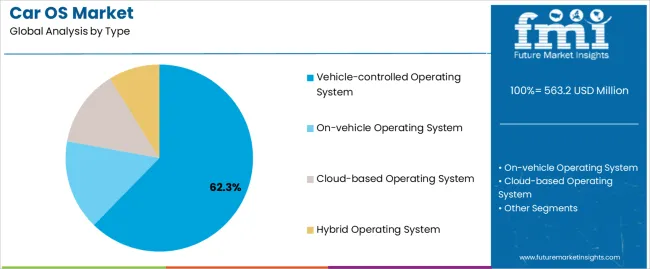
The vehicle-controlled operating system segment is projected to account for 62.3% of the car OS market in 2025, reaffirming its position as the leading type category. Automotive manufacturers and technology developers increasingly utilize vehicle-controlled systems for their superior integration characteristics, established performance standards, and essential functionality in diverse vehicle applications across multiple automotive segments. Vehicle-controlled OS platforms' proven performance characteristics and established reliability directly address manufacturer requirements for dependable system management and optimal vehicle integration precision in passenger and commercial vehicle applications.
This type segment forms the foundation of modern automotive software performance patterns, as it represents the technology category with the greatest integration potential and established compatibility across multiple vehicle management systems. Manufacturer investments in advanced OS technology and performance optimization continue to strengthen adoption among innovation-focused developers. With manufacturers prioritizing system reliability and integration consistency, vehicle-controlled systems align with both performance objectives and development requirements, making them the central component of comprehensive automotive software strategies.
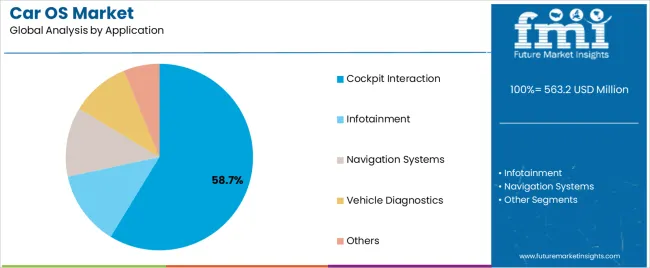
Cockpit interaction is projected to represent 58.7% of the car OS market in 2025, underscoring its critical role as the primary application for technology-focused manufacturers seeking superior user experience benefits and enhanced vehicle interface management credentials. Automotive developers and manufacturers prefer cockpit interaction applications for their established user engagement requirements, proven consumer demand, and ability to maintain exceptional interface quality while supporting versatile functionality during diverse driving activities. Positioned as essential applications for innovation-focused manufacturers, cockpit interaction offerings provide both user experience excellence and competitive differentiation advantages.
The segment is supported by continuous improvement in human-machine interface technology and the widespread availability of established user experience standards that enable interface assurance and premium positioning at the manufacturer level. Automotive developers are optimizing OS selections to support application-specific implementations and comprehensive vehicle digitalization strategies. As connected vehicle technology continues to advance and manufacturers seek efficient user engagement methods, cockpit interaction applications will continue to drive market growth while supporting user satisfaction and automotive interface quality strategies.
The car OS market is advancing rapidly due to increasing digital transformation in the automotive industry and growing need for sophisticated software platforms that emphasize superior integration performance across connected vehicle segments and autonomous driving applications. The car OS market faces challenges, including cybersecurity concerns in connected systems, legacy system integration complexities, and development cost considerations affecting adoption rates. Innovation in edge computing integration and advanced security frameworks continues to influence market development and expansion patterns.
The growing adoption of car OS platforms with artificial intelligence capabilities and autonomous driving integration is enabling manufacturers to develop vehicle systems that provide distinctive intelligence benefits while commanding automated operation and enhanced real-time decision-making characteristics. AI applications provide superior processing consistency while allowing more sophisticated vehicle automation features across various automotive categories. Manufacturers are increasingly recognizing the operational advantages of AI-enabled positioning for comprehensive vehicle intelligence outcomes and technology-integrated automotive development.
Modern car OS developers are incorporating advanced cloud connectivity, over-the-air update capabilities, and remote management systems to enhance platform flexibility, improve feature deployment effectiveness, and meet manufacturer demands for intelligent vehicle lifecycle management solutions. These systems improve operational effectiveness while enabling new applications, including continuous feature updates and predictive maintenance protocols. Advanced connectivity integration also allows manufacturers to support proactive vehicle management positioning and performance assurance beyond traditional automotive software operations.
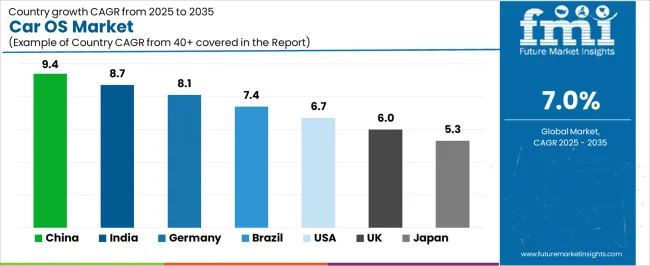
| Country | CAGR (2025-2035) |
|---|---|
| China | 9.4% |
| India | 8.7% |
| Germany | 8.1% |
| Brazil | 7.4% |
| USA | 6.7% |
| UK | 6.0% |
| Japan | 5.3% |
The car OS market is experiencing robust growth globally, with China leading at a 9.4% CAGR through 2035, driven by the expanding electric vehicle industry, growing automotive technology requirements, and increasing adoption of advanced connected vehicle systems. India follows at 8.7%, supported by rising automotive production, expanding technology infrastructure, and growing acceptance of digital vehicle technologies. Germany shows growth at 8.1%, emphasizing established automotive excellence and comprehensive vehicle technology development. Brazil records 7.4%, focusing on automotive modernization and technology consciousness growth. The USA demonstrates 6.7% growth, prioritizing advanced automotive technologies and innovation optimization.
The report covers an in-depth analysis of 40+ countries, with top-performing countries highlighted below.
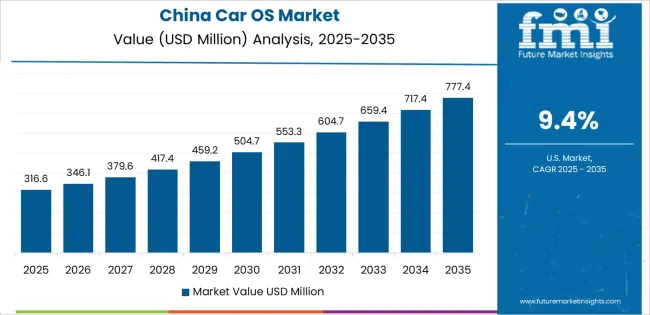
Revenue from car OS consumption and sales in China is projected to exhibit exceptional growth with a CAGR of 9.4% through 2035, driven by the country's rapidly expanding electric vehicle sector, favorable government policies toward automotive digitalization, and initiatives promoting connected vehicle technologies across major automotive manufacturing regions. China's position as a leading automotive production hub and increasing focus on intelligent transportation systems are creating substantial demand for high-quality car OS platforms in both domestic and export markets. Major automotive companies and technology distributors are establishing comprehensive software development capabilities to serve growing demand and emerging digitalization opportunities.
Demand for car OS products in India is expanding at a CAGR of 8.7%, supported by rising automotive production investment, growing technology consciousness, and expanding software developer capabilities. The country's developing automotive infrastructure and increasing manufacturer investment in digital technologies are driving demand for car OS platforms across both traditional and modern vehicle applications. International automotive companies and domestic technology developers are establishing comprehensive operational networks to address growing market demand for vehicle digitalization and efficient software solutions.
Revenue from car OS products in Germany is projected to grow at a CAGR of 8.1% through 2035, supported by the country's mature automotive industry, established vehicle technology standards, and leadership in automotive innovation. Germany's sophisticated automotive ecosystem and strong support for advanced vehicle systems are creating steady demand for both traditional and innovative car OS varieties. Leading automotive manufacturers and specialty technology providers are establishing comprehensive operational strategies to serve both domestic markets and growing export opportunities.
Demand for car OS products in Brazil is anticipated to expand at a CAGR of 7.4% through 2035, driven by the country's emphasis on automotive modernization, technology consciousness growth, and growing software developer capabilities. Brazilian manufacturers and automotive users consistently seek technology-focused solutions that enhance vehicle capabilities and support innovation excellence for both traditional and modern automotive applications. The country's position as a Latin American automotive market leader continues to drive innovation in specialized vehicle software applications and automotive technology standards.
Revenue from car OS products in the USA is projected to grow at a CAGR of 6.7% through 2035, supported by the country's emphasis on automotive technology advancement, vehicle digitalization optimization, and advanced connectivity integration requiring efficient software solutions. American manufacturers and technology-conscious developers prioritize performance reliability and innovation precision, making specialized car OS platforms essential components for both traditional and modern vehicle software applications. The country's comprehensive automotive technology leadership and advancing digitalization patterns support continued market expansion.
Demand for car OS products in the UK is anticipated to grow at a CAGR of 6.0% through 2035, supported by established automotive technology standards, mature manufacturer markets, and emphasis on software reliability across vehicle and commercial sectors. British manufacturers and technology-conscious professionals prioritize quality performance and system consistency, creating steady demand for premium software solutions. The country's comprehensive market maturity and established technology practices support continued development in specialized applications.
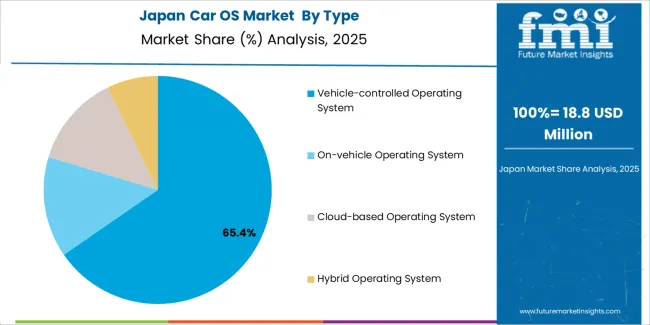
Revenue from car OS products in Japan is projected to expand at a CAGR of 5.3% through 2035, supported by the country's emphasis on precision manufacturing, automotive excellence, and advanced technology integration requiring efficient software solutions. Japanese manufacturers and technology-focused developers prioritize technical performance and manufacturing precision, making specialized car OS platforms essential components for both traditional and modern vehicle software applications. The country's comprehensive automotive leadership and advancing technology patterns support continued market expansion.

The Europe car OS market is projected to grow from USD 162.4 million in 2025 to USD 298.7 million by 2035, recording a CAGR of 6.3% over the forecast period. Germany leads the region with a 43.2% share in 2025, moderating slightly to 42.8% by 2035, supported by its strong automotive manufacturing base and demand for premium, technologically advanced vehicle software solutions. The United Kingdom follows with 21.7% in 2025, easing to 21.3% by 2035, driven by a mature technology-conscious automotive market and emphasis on vehicle software reliability and technological performance. France accounts for 14.9% in 2025, rising to 15.4% by 2035, reflecting steady adoption of automotive technology and digitalization enhancement. Italy holds 8.8% in 2025, expanding to 9.3% by 2035 as technology consciousness and specialty automotive applications grow. Spain contributes 6.1% in 2025, growing to 6.4% by 2035, supported by expanding automotive development and technology awareness modernization. The Nordic countries rise from 3.2% in 2025 to 3.4% by 2035 on the back of strong technology consciousness and advanced automotive methodologies. BENELUX remains at 2.1% share across both 2025 and 2035, reflecting mature, technology-focused automotive markets.
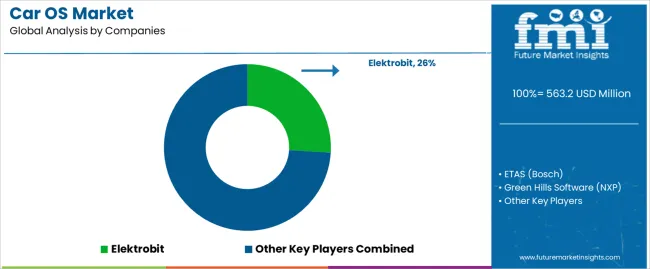
The car OS market is characterized by competition among established technology companies, specialized automotive software providers, and integrated vehicle system developers. Companies are investing in advanced AI technologies, cloud-native platforms, product innovation capabilities, and comprehensive developer ecosystems to deliver consistent, high-quality, and reliable car OS solutions. Innovation in system integration, cybersecurity optimization, and user experience-focused product development is central to strengthening market position and customer satisfaction.
Elektrobit leads the car OS market with a strong focus on automotive software innovation and comprehensive car OS solutions, offering embedded and cloud-based systems with emphasis on performance excellence and automotive heritage. ETAS (Bosch) provides specialized automotive software with a focus on European market applications and precision engineering networks. Green Hills Software (NXP) delivers integrated safety-critical solutions with a focus on real-time positioning and reliability efficiency. Wind River Systems specializes in comprehensive embedded systems with an emphasis on connectivity applications. BlackBerry focuses on comprehensive automotive cybersecurity with advanced security and premium positioning capabilities.
The success of car OS platforms in meeting manufacturer digitalization demands, automotive software requirements, and technology integration will not only enhance vehicle capabilities but also strengthen global automotive technology development capabilities. It will consolidate emerging regions' positions as hubs for efficient automotive software production and align advanced economies with comprehensive digitalization systems. This calls for a concerted effort by all stakeholders -- governments, industry bodies, manufacturers, developers, and investors. Each can be a crucial enabler in preparing the car OS market for its next phase of growth.
How Governments Could Spur Local Production and Adoption?
How Industry Bodies Could Support Market Development?
How Developers and Automotive Industry Players Could Strengthen the Ecosystem?
How Manufacturers Could Navigate the Shift?
| Items | Values |
|---|---|
| Quantitative Units (2025) | USD 563.2 million |
| Type | Vehicle-controlled Operating System, On-vehicle Operating System, Cloud-based Operating System, Hybrid Operating System |
| Application | Cockpit Interaction, Infotainment, Navigation Systems, Vehicle Diagnostics, Others |
| Deployment Model | Embedded Systems, Cloud-native Platforms, Edge Computing Solutions, Distributed Architectures |
| Vehicle Type | Passenger Cars, Commercial Vehicles, Electric Vehicles, Autonomous Vehicles |
| Regions Covered | North America, Europe, Asia Pacific, Latin America, Middle East & Africa, Other Regions |
| Countries Covered | China, India, Germany, Brazil, United States, United Kingdom, Japan, and 40+ countries |
| Key Companies Profiled | Elektrobit, ETAS (Bosch), Green Hills Software (NXP), Wind River Systems, BlackBerry, and other leading car OS companies |
| Additional Attributes | Dollar sales by type, application, deployment model, vehicle type, and region; regional demand trends, competitive landscape, technological advancements in automotive software engineering, precision integration initiatives, digitalization enhancement programs, and premium platform development strategies |
The global car os market is estimated to be valued at USD 563.2 million in 2025.
The market size for the car os market is projected to reach USD 1,107.9 million by 2035.
The car os market is expected to grow at a 7.0% CAGR between 2025 and 2035.
The key product types in car os market are vehicle-controlled operating system , on-vehicle operating system, cloud-based operating system and hybrid operating system.
In terms of application, cockpit interaction segment to command 58.7% share in the car os market in 2025.






Full Research Suite comprises of:
Market outlook & trends analysis
Interviews & case studies
Strategic recommendations
Vendor profiles & capabilities analysis
5-year forecasts
8 regions and 60+ country-level data splits
Market segment data splits
12 months of continuous data updates
DELIVERED AS:
PDF EXCEL ONLINE
Carnosic Acid Market Analysis by Function, Application, Form and Region Through 2025 to 2035
Carbon Free Hose Market Analysis - Size, Share, and Forecast Outlook 2025 to 2035
Cardiovascular Prosthetic Devices Market Size and Share Forecast Outlook 2025 to 2035
Carbon Fiber Composites Market Size, Growth, and Forecast 2025 to 2035
Carbon Fiber Composites for Prosthetics Market 2025-2035
Cardiovascular Diagnostics Market Report- Trends & Innovations 2025 to 2035
Carboxymethyl Cellulose Market 2024-2034
Cardiac Biomarker Diagnostic Test Kits Market Analysis – Trends & Forecast 2025 to 2035
Carbon-Dioxide Synthesis Cosmetics Market Size and Share Forecast Outlook 2025 to 2035
Croscarmellose Sodium Market Size and Share Forecast Outlook 2025 to 2035
Polycarbonate Composites Market Size and Share Forecast Outlook 2025 to 2035
Critical Care Diagnostics Market Size and Share Forecast Outlook 2025 to 2035
Point-of-Care Diagnostics Market Size and Share Forecast Outlook 2025 to 2035
Personal Care and Cosmetics Microalgae Market - Beauty & Skincare Trends 2025 to 2035
Point-of-care Molecular Diagnostics Market Insights – Trends & Growth 2025 to 2035
Composite Cardboard Tube Packaging Market Size and Share Forecast Outlook 2025 to 2035
Composite Cardboard Tubes Market from 2025 to 2035
Breaking Down Market Share in Composite Cardboard Tube Packaging
Post Shave Care Products Market Size and Share Forecast Outlook 2025 to 2035
Post-Shave Care Market Growth - Size, Demand & Forecast 2024 to 2034

Thank you!
You will receive an email from our Business Development Manager. Please be sure to check your SPAM/JUNK folder too.
Chat With
MaRIA